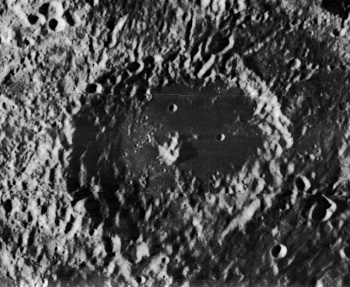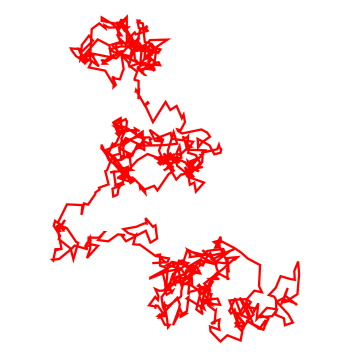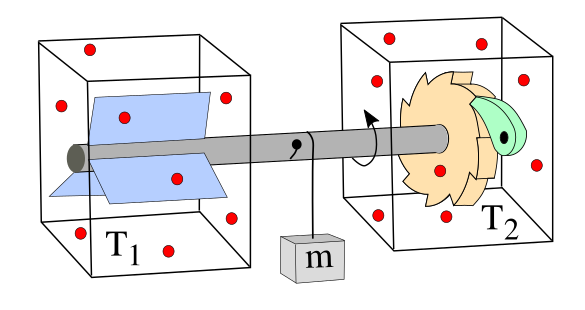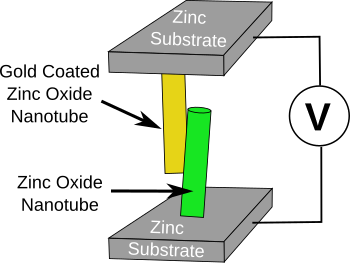Brownian Motion Energy Harvesting
January 15, 2024
Human
visual acuity is quite remarkable. We can"
resolve objects as small as 0.1
millimeters (100
micrometers) such as a
human hair whose general
width (a
hair's breadth) is about the same, and as wide as 181 micrometers. For long distances, the eye's
angular resolution of about 1
arc-minute gives us the ability to resolve objects 30
centimeters apart at a distance of 1
kilometer. Since the
semi-major axis of the
Moon's orbit around the
Earth is about 385,000 kilometers, we can resolve objects there spaced about 115 kilometers apart, which is about three quarters the distance from
New York City to
Philadelphia.

Leeuwenhoek Crater, located on the far side of the Moon in the Moon's southern hemisphere.
Antonie van Leeuwenhoek (1632-1723) was a Dutch microscopist, microbiologist, and the "Father of Microbiology." He began his microbiology research several decades after the invention of the microscope. He created his microscope lenses by melting the ends of soda lime glass fibers into ball lenses.
Wikimedia Commons image based on a NASA Lunar Orbiter 2 image.
Most of
science advances through improvement in
scientific instrumentation.
Microscopes and
optical telescopes have given us the ability to see things in greater detail than can be seen with the unaided
eye. The
invention of the
microscope is credited to
German-Dutch spectacle-maker,
Hans Lipperhey (c.1570-1619). Lipperhey is also credited with the 1608 invention of the
refracting telescope. A refracting telescope, now known as the
Galilean telescope, was perfected the following year by
Galileo Galilei (1564-1642). Galileo was the first to use a telescope for
astronomical observations that were detailed in his 1610
publication,
Sidereus Nuncius, and he also designed and constructed an improved microscope shortly after 1624.
Nobel Physics Laureate,
Ernest Rutherford (1871-1937), once said that "
all science is either physics or stamp collecting." Indeed, the early years of microscopy were just
stamp collecting, the discovery and
classification of
microscale organisms. The first
physics by microscopy was the
observation of
Brownian motion, the
random motion of
particles suspended in a fluid, by
botanist,
Robert Brown (1773-1858). In 1827, Brown observed the random motion in
water of
pollen grains of about 10 micrometers in size.

A thousand step simulation of Brownian motion in two dimensions.
(A Wikimedia Commons image, modified, by PAR. Click for larger image.)
Brownian motion was explained by
Albert Einstein in 1905 in one of his four
Annus mirabilis (miracle year) papers in the
scientific journal,
Annalen der Physik. Einstein had the
insight to consider Brownian particles, which are much larger than water
molecules, to be just another type of molecule in a
solution for which ordinary
statistical mechanics can be applied. This theory of Brownian motion was an affirmation of the existence of
atoms and molecules.
French physicist,
Jean Perrin (1870-1942), was awarded the 1926
Nobel Prize in Physics for his
experimental confirmation of this (
for his work on the discontinuous structure of matter...) in 1908. Details of the
history of Brownian motion can be found in refs. 1-4.[1-4]
In 1900, physicist and subsequent Nobel Physics Laureate,
Gabriel Lippmann (1845-1921), proposed a
thought experiment in
thermodynamics that's now known as the
Brownian ratchet (see figure). This is a device to
harvest the energy from the motion of Brownian particles that appears to be a
perpetual motion machine, thereby violating the
second law of thermodynamics. An
analysis in the 1960s by
Richard Feynman (1918-1988) showed that work will be done only if the
temperature T
1 > T
2, reducing the device to a typical
heat engine that obeys all
laws of thermodynamics.

diagram of the Brownian ratchet. The size and construction of the device are assumed to be adjusted such that the paddles will be moved by impact with the gas molecules. The paddle wheels would rotate the shaft in one direction only because of the ratchet mechanism. Work is done in lifting the mass m against gravity, but only if T1>T2. (Created by the author using Inkscape. Also available at Wikimedia Commons. Click for larger image.)
A recent
open access paper in
APL Materials by a research team from East Eight Energy Co., Ltd. (
Shanghai, China) and
Nankai University (Tianjin, China) reports on a
piezoelectric energy harvester of Brownian motion.[5-6] This device builds from previous research that demonstrated the Brownian motion of
tethered nanowires in
liquid.[7-8] There exists considerable
energy in
thermal motion. As an example, the average
kinetic energy of thermal motion per
mole of molecules in an
ideal gas at
room temperature is 3.7
kilojoules.[5] The researchers call their device a molecular thermal motion harvester, or MTMH.[5]
The device uses
arrays of
Zinc oxide (ZnO) nanowires, selected because they're easy to create, and ZnO is a piezoelectric
material.[6] The device has top and bottom interpenetrating arrays of such nanowires, the top array being
gold coated (see figure). The space between the arrays is filled with a
non-conductive liquid, the molecules of which cause the nanowires to undergo
worm-like bending,
flexing, or
wriggling.[5]

Molecular motion energy harvester using Zinc oxide (ZnO) nanowires.
This diagram shows just two of many nanowires of the device. High purity n-octane fills the space between the nanowires
The thermal motion of the molecules of the liquid causes the nanowires to bend, thereby producing an electrical charge via the piezoelectric effect.
(Created using Inkscape.)
The liquid medium for the device was
electronic-grade, "four-nines"
purity (99.99%),
n-octane, with a purity of greater than 99.99
percent.[6] The n-octane has a suitable
boiling point, low
dielectric constant, low
toxicity, and low
viscosity.[5] Its high purity was essential to reduce conductivity from
ions, which would
discharge the ZnO nanowires.[5] In the device, the gold-coated nanowires were used as the
negative electrode, and the uncoated piezoelectric ZnO nanowires as the
positive electrode.[6] The 2
centimeter by 2 centimeter device was sealed with
epoxy.[6] The easy flexibility of the nanowires was essential to device operation.
At room temperature, the device had an output
voltage of 2.28
millivolts, and an output
current of 2.47
nanoamperes, with these values increasing with the liquid temperature.[5-6]
Parameters influencing device performance are
friction from
interfacial tension,
viscous drag force from the surrounding fluid, and temperature.[5] The demonstrated device produces a mere 5
picowatts; however, better versions of such an energy harvester would be useful in low power
Internet-of-things (IOT) devices, especially since
mechanical vibration will also generate power in such a device.
References:
- This Month in Physics History - Einstein and Brownian Motion. APS News, vol. 14, no. 2 (February, 2005).
- Einstein's random walk, Physics World, January 15, 2005.
- David Cassidy, "Einstein on Brownian Motion," adapted from "Einstein and Our World" by David Cassidy, Humanity Books (Amherst, New York: 1998).
- Nino Zanghì, "Brownian Motion," Dipartimento di Fisica, Università di Genova.
- Yucheng Luan, Fengwei Huo, Mengshi Lu, Wei Li, and Tonghao Wu, "Molecular thermal motion harvester for electricity conversion," APL Materiaals, vol. 11 (October 17 2023), article 101118, https://doi.org/10.1063/5.0169055, This is an open access article with a link to a PDF file at this same URL.
- Payal Dhar, "Einstein Made It Famous; Tech Makes It Current," IEEE Spectrum, October 27, 2023.
- Sadao Ota, Tongcang Li, Yimin Li, Ziliang Ye, Anna Labno, Xiaobo Yin, Mohammad-Reza Alam, and Xiang Zhang, "Brownian motion of tethered nanowires," Phys. Rev. E., vol. 89, no. 5 (May 13, 2014), article no. 053010, DOI:https://doi.org/10.1103/PhysRevE.89.053010.
- M. T. Gallagher, C. V. Neal, K. P. Arkill, and D. J. Smith, "Model-based image analysis of a tethered Brownian fibre for shear stress sensing," J. R. Soc., Interface, vol. 14, no. 137 (December 6, 2017), article no 20170564, https://doi.org/10.1098/rsif.2017.0564.
Linked Keywords: Visual acuity; angular resolution; resolve; millimeter; micrometer; human hair; diameter; width; hair's breadth; arc-minute; centimeter; kilometer; semi-major axis; Moon; orbit; Earth; New York City; Philadelphia; Leeuwenhoek Crater; far side of the Moon; southern hemisphere; Antonie van Leeuwenhoek (1632-1723); Netherlands; Dutch; microscopist; microbiologist; research; decades; invention; optical microscope; lens (optics); melting; soda lime glass; glass fiber; ball lens; Wikimedia Commons; NASA Lunar Orbiter 2; science; scientific instrument; scientific instrumentation; optical telescope; human eye; Germany; German-Dutch; glasses; spectacle-maker; Hans Lipperhey (c.1570-1619); refracting telescope; Galilean telescope; Galileo Galilei (1564-1642); observational astronomy; astronomical observation; academic publishing; publication; Sidereus Nuncius; Nobel Physics Laureate; Ernest Rutherford (1871-1937); all science is either physics or stamp collecting; taxonomy (biology); classification; nanoscopic scale; microscale; organism; physics; observation in science; Brownian motion; randomness; random; particle; suspension (chemistry); suspended; botanist; Robert Brown (1773-1858); water; pollen grain; computer simulation; two-dimensional space; User:PAR; Albert Einstein; Annus mirabilis (miracle year) papers; scientific journal; Annalen der Physik; insight; molecule; solution; statistical mechanics; atom; France; French; Jean Perrin (1870-1942); Nobel Prize in Physics; experiment; experimental; discontinuous structure of matter; history; Gabriel Lippmann (1845-1921); thought experiment; thermodynamics; Brownian ratchet; energy harvesting; harvest the energy; perpetual motion machine; second law of thermodynamics; analysis; Richard Feynman (1918-1988); temperature; heat engine; laws of thermodynamics; schematic; diagram; paddle; impact (mechanics); gas molecule; rotation; rotate; ratchet (device); ratchet mechanism; work (physics); mass; gravitational field; gravity; Inkscape; open access paper; APL Materials; Shanghai, China; Nankai University (Tianjin, China); piezoelectricity; piezoelectric; tether; tethered; nanowire; liquid; energy; kinetic theory of gases; thermal motion; kinetic energy; mole (unit); ideal gas; room temperature, scientific use; Joule; kilojoule; array; Zinc oxide (ZnO); material; gold; coating; coated; electrical conductor; non-conductive; worm-like; bending; deflection (engineering); flexing; wriggle; wriggling; molecule; molecular; motion (physics); impurity; purity; n-octane; electrical charge; piezoelectric effect; Inkscape; electronics; electronic-grade; percentage; percent; boiling point; relative permittivity; dielectric constant; toxicity; viscosity; ion; electrostatic discharge; cathode; negative electrode; anode; positive electrode; epoxy; voltage; volt; millivolt; electric current; ampere; nanoampere; parameter; friction; surface tension; interfacial tension; drag (physics); viscous drag force; watt; picowatt; Internet-of-things (IOT) devices; mechanical vibration.